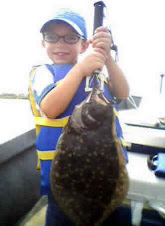Summertime weather and warm inshore water should provide a variety of small bottom fish to keep surfcasters busy along the northern beaches this week.
Small croaker will be abundant almost anywhere along the beaches. They should be easily taken, using almost any type of bait on small hooks. Fair numbers of small spot also should be caught fairly regularly on bloodworms. There is no size or creel limit on small bottom fish such as spot, croaker and sea mullet, but anglers should keep only what they intend to use.
The best time for fishing for these small bottom fish will likely be on the incoming or high tide. If the weather is hot and skies are cloudless, early morning and late afternoon anglers should have the best luck.
A few flounder and an occasional pompano also should be landed by bottom-fishing surfcasters.
Fair numbers of small bluefish should be taken regularly on metal lures if the water is clear, and on fresh cut bait if the water is dirty. Steel leaders are a must for successful bluefish catches, as these aggressive fish have very sharp teeth that can make quick work of most monofilament.
Northern beach pier anglers should deck plenty of small croaker, some small spot, pigfish, sand perch and scattered sea mullet when the water is somewhat murky.
Bluefish action should be good with 1/2- to 2-pound tailor blues caught from the ends of ocean piers when the water is clear. Fishing should be most productive early mornings and at sunset.
When light onshore winds push clear, warm Gulf Stream water in close to the beach, pier jockeys should land some spadefish, triggerfish and filefish around pier pilings. These fish congregate around inshore structures when the water is clear, feeding on small crustaceans and worms.
Lots of small flounder should be hooked and released, and a few nice-sized flounder will be decked. Most of the keeper flounder will be taken on live minnows fished inshore close to the pier pilings. Anglers can keep eight flounder, 15 1/2 inches or larger in total length per person per day. Total length is measured from the tip of the snout with the mouth closed to the top of the compressed tail.
Live-bait anglers should catch an occasional king mackerel, jack crevalle or cobia during periods of light onshore winds when water temperatures are high.
Anglers trying their luck from the Melvin Daniels Jr. Bridge on the Nags Head/Roanoke Island causeway should land a few speckled trout and flounder just about every morning at first light. Scattered small bottom fish and black drum should be taken during the day. Action should be best when winds are from the northeast.
Oregon Inlet area
Anglers fishing from the catwalk on the south end of the Bonner Bridge across Oregon Inlet should catch some nice sheepshead and a few black drum around bridge pilings. Some small bottom fish, bluefish and a few flounder also will be landed from the catwalk.
A few trout and small bottom fish should be reeled in from the Off Island Channel behind the Bodie Island Lighthouse, but fishing has been slow in the area recently because of grass.
Pea Island to Buxton
Pinhead croaker, small spot, sand perch and pigfish should keep surfcasters busy in this area. Bloodworms and fresh shrimp on No. 4 to 6 hooks should provide the best results.
Scattered mixed-sized flounder and a few pompano also should be beached by bottom-fishing anglers. Sand fleas, also called mole crabs, usually prove to be the most effective bait for pompano. These small crustaceans, which burrow in the high energy surf zone amid the breaking waves, are the favorite food of not only pompano, but also of sea mullet.
Small bluefish should be fairly abundant along the beach in this area with action particularly good when the water is clear. Some Spanish mackerel also should appear in catches. Most of the bluefish and Spanish mackerel should be taken on Stingsilver lures. Anglers can keep 15 bluefish per person per day, with no more than five greater than 24 inches. There is no minimum size limit on bluefish.
Pier anglers along the northern beaches of Hatteras Island should deck lots of pesky pinhead croaker along with small spot, pigfish, sand perch and sea mullet when the water is slightly stirred up. A few gray trout and speckled trout, keeper flounder, sheepshead and spadefish also should appear in catches. Lots of small flounder should be released.
Quite a few bluefish and some nice-sized Spanish mackerel should be caught on Gotchas from the ends of piers when the water is clear. Action should be best at sunrise and sunset, but sometimes it will continue off and on all day. Anglers can keep 15 Spanish mackerel 12 inches or larger in fork length per person per day. Fork length is measured from the tip of the snout to the middle of the fork in the tail.
A king mackerel, big jack, cobia or barracuda could be landed at any time by a live-bait angler when winds are light and the water is clear and warm.
Subscribe to:
Post Comments (Atom)








No comments:
Post a Comment